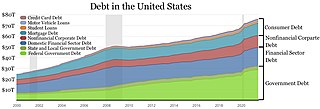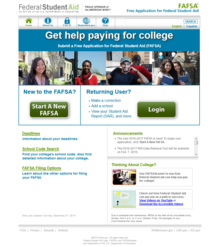
The National Defense Education Act (NDEA) was signed into law on September 2, 1958, providing funding to United States education institutions at all levels.

A student loan is a type of loan designed to help students pay for post-secondary education and the associated fees, such as tuition, books and supplies, and living expenses. It may differ from other types of loans in the fact that the interest rate may be substantially lower and the repayment schedule may be deferred while the student is still in school. It also differs in many countries in the strict laws regulating renegotiating and bankruptcy. This article highlights the differences of the student loan system in several major countries.
Student financial aid in the United States is funding that is available exclusively to students attending a post-secondary educational institution in the United States. This funding is used to assist in covering the many costs incurred in the pursuit of post-secondary education. Financial aid is available from federal and state governments, educational institutions, and private organizations. It can be awarded in the form of grants, loans, work-study, and scholarships. In order to apply for federal financial aid, students must first complete the Free Application for Federal Student Aid (FAFSA).
A Pell Grant is a subsidy the U.S. federal government provides for students who need it to pay for college. Federal Pell Grants are limited to students with exceptional financial need, who have not earned their first bachelor's degree, or who are enrolled in certain post-baccalaureate programs, through participating institutions. Originally known as a Basic Educational Opportunity Grant, it was renamed in 1980 in honor of Democratic U.S. Senator Claiborne Pell of Rhode Island. A Pell Grant is generally considered the foundation of a student's financial aid package, to which other forms of aid are added. The Federal Pell Grant program is administered by the United States Department of Education, which determines the student's financial need and through it, the student's Pell eligibility. The U.S. Department of Education uses a standard formula to evaluate financial information reported on the Free Application for Federal Student Aid (FAFSA) for determining the student's Expected Family Contribution (EFC).
A Federal Perkins Loan, also referred to as a Perkins Loan, was a need-based student loan offered by U.S. Department of Education from 1958 until 2017. Created as part of the Federal Direct Student Loan Program, the Perkins Loan served to assist American college students fund their post-secondary education. The program was named after Carl D. Perkins, a former member of the U.S. House of Representatives from Kentucky.
The National Science and Mathematics Access to Retain Talent (SMART) Grant was a need based federal grant that was awarded to undergraduate students in their third and fourth year of undergraduate studies. The National SMART grant was introduced to help maintain the edge that United States has in the fields of Science and Technology. Only specific majors were eligible for the SMART grant, the complete list is given below.
The Federal Supplemental Educational Opportunity Grant, more commonly known by its acronym SEOG, is a federal assistance grant reserved for college students with the greatest need for financial aid to attend school. To be eligible for this grant, applicants must meet all of the following criteria:
- To be a United States citizen or eligible non-citizen,
- To not have a bachelor's degree,
- To not be in default of any federal student loan,
- To not have a Federal Pell Grant overpayment,
- To file their FAFSA.
A Stafford Loan was a student loan offered from the United States Department of Education to eligible students enrolled in accredited American institutions of higher education to help finance their education. The terms of the loans are described in Title IV of the Higher Education Act of 1965, which guarantees repayment to the lender if a student defaults. As of July 1, 2010, Stafford Loans are no longer being offered, having been replaced with the William D. Ford Federal Direct Student Loan Program.
A PLUS Loan is a student loan, which is part of the Federal Direct Student Loan Program, offered to parents of students enrolled at least half time, or graduate and professional students, at participating and eligible post-secondary institutions. The original, now obsolete, meaning of the acronym was "Parent Loan for Undergraduate Students".
The Federal Family Education Loan (FFEL) Program was a system of private student loans which were subsidized and guaranteed by the United States federal government. The program issued loans from 1965 until it was ended in 2010. Similar loans are now provided under the Federal Direct Student Loan Program, which are federal loans issued directly by the United States Department of Education.
The William D. Ford Federal Direct Loan Program provides "low-interest loans for students and parents to help pay for the cost of a student's education after high school. The lender is the U.S. Department of Education ... rather than a bank or other financial institution." It is the largest single source of federal financial aid for students and their parents pursuing post-secondary education and for many it is the first financial obligation they incur, leaving them with debt to be paid over a period of time that can be a decade or more as the average student takes 19.4 years. The program is named after William D. Ford, a former member of the U.S. House of Representatives from Michigan.
Federal Student Aid (FSA), an office of the U.S. Department of Education, is the largest provider of student financial aid in the United States. Federal Student Aid provides student financial assistance in the form of grants, loans, and work-study funds. FSA is a Performance-Based Organization, and was the first PBO to be established in the US government.
Graduate PLUS is a type of federal student aid, in the form of student loans, which is available to graduate and professional students. Similar to the Parent PLUS loan for parents of dependent undergraduate students, the Graduate PLUS loan is an unsubsidized federally guaranteed education loan with no annual or aggregate limits. It has no grace period and it goes into repayment as soon as the funds are disbursed to the borrower. It has the same deferment and forbearance options as the federal Stafford loan program. As such, graduate and professional students can postpone repayment using in-school deferment while enrolled at least half-time in a degree or certificate program of study.
In the United States, the Federal Direct Student Loan Program (FDLP) includes consolidation loans that allow students to consolidate Stafford Loans, Graduate PLUS Loans, and Federal Perkins Loans into one single debt.

In the United States, student loans are a form of financial aid intended to help students access higher education. In 2018, 70 percent of higher education graduates had used loans to cover some or all of their expenses. With notable exceptions, student loans must be repaid, in contrast to other forms of financial aid such as scholarships, which are not repaid, and grants, which rarely have to be repaid. Student loans may be discharged through bankruptcy, but this is difficult. Research shows that access to student loans increases credit-constrained students' degree completion, later-life earnings, and student loan repayment while having no impact on overall debt.
In the post-secondary education system of the United States, an expected family contribution (EFC) is an estimate of a student's, and for a dependent student, their parent(s)' or guardian(s)', ability to pay the costs of a year of post-secondary education. The EFC is used in the United States student financial aid process to determine an applicant's eligibility for need-based federal student aid. In most cases, the same estimate is also used for state and institutional (college-based) financial aid. The EFC is included on the Student Aid Report and Institutional Student Information Record, which are sent after filing a form called a Free Application for Federal Student Aid (FAFSA).
The Federal Work-Study Program originally called the College Work-Study Program and in the United States frequently referred to as just "Work-study", is a federally-funded program in the United States that assists students with the costs of post-secondary education. The Federal Work-Study Program helps students earn financial funding through a part-time employment program. Approximately 3,400 institutions participate in the program.
The Public Service Loan Forgiveness (PSLF) program is a United States government program that was created under the College Cost Reduction and Access Act of 2007 signed into law by President George W. Bush to provide indebted professionals a way out of their federal student loan debt burden by working full-time in public service.
The FAFSA position is a historical term in college admissions in the United States that referred to the position where a prospective college appeared on an applicant's FAFSA form. FAFSA permits an applicant to list up to ten colleges on the form, and the entire list was historically sent to each college. As a result, admissions officers could see which other colleges a student is applying to and the order in which the colleges were listed.
A scholarship is defined as a grant or payment made to support a student's education, awarded on the basis of academic or other distinction. "Scholarship" has a different meaning in the United States than it does in other countries, with the partial exception of Canada. Outside the U.S., scholarship is any type of monetary award to fund education. In the United States, the only country with a national system that determines a student's financial need, and where universities are far more expensive than in other countries, a scholarship is money for which the student must qualify in some way, and the term "grant" - an award the student receives because of financial need - is used for what in other countries are called scholarships.



